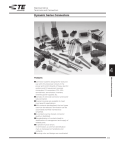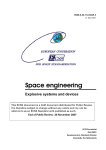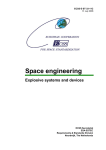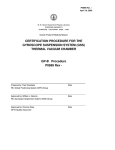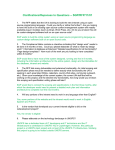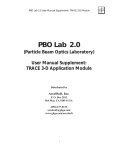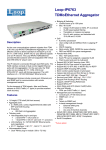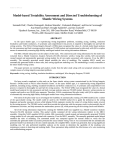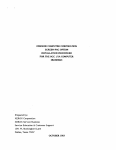Download Attach Vacuum System And Leak Check Probe C
Transcript
STANFORD UNIVERSITY W.W. HANSEN EXPERIMENTAL PHYSICS LABORATORY GRAVITY PROBE B, RELATIVITY GYROSCOPE EXPERIMENT STANFORD, CALIFORNIA 94305-4085 ATTACH VACUUM SYSTEM AND LEAK CHECK PROBE C GP-B SCIENCE MISSION PROCEDURE P0410 June 7, 1999 PREPARED _______________________________________ R. Brumley, Gyroscope RE _________________ Date APPROVED _______________________________________ C. Gray, Gyroscope Verification _________________ Date APPROVED _______________________________________ D. Ross, Quality Assurance and Safety _________________ Date APPROVED _______________________________________ S. Buchman, Hardware Manager _________________ Date 1 P0410 Rev - Attach Vacuum System and Leak Check Probe C 1. SCOPE This procedure covers the following items in preparation for the room-temperature checkout of the science mission gyroscopes in Probe C: • Install the pumping system onto Probe C • Pump-down of Probe C • Leak checking Probe C It takes place inside the Class 1000 clean room. 2. REFERENCES 2.1 Plans and Procedures P0481 Levitation of Gyroscopes in Probe C P0505 RT Spinup of Gyroscopes in Probe C P0178 Room-temperature Checkout of SM Gyroscopes in Probe C 3. GENERAL REQUIREMENTS 3.1 Environmental Requirements 3.1.1 Cleanliness This procedure takes place in the Class 1000 cleanroom in the HEPL building. Minimum protective garments for personnel working in the clean rooms shall be the standard Tyvek clean room apparel. All activities taking place within this room must be in accordance with the guidelines established by the cleanroom manager. 3.1.2 Particulate Contamination All connectors shall be inspected and verified free of particulate contamination before they are mated to Probe C. It is also desirable to keep the probe in general clean and free of particulate contamination. 3.1.3 Magnetic Contamination This procedure takes place after the vacuum can is sealed, making the experiment much less sensitive to magnetic contamination. However, great care shall still be taken to avoid cross contamination between any magnetic (e.g. steel) item and the probe, particularly on the probe's "cold" end. Therefore no magnetic items may be used in the immediate vicinity of the "cold" end of the probe. 3.2 Test Personnel 2 P0410 Rev - Attach Vacuum System and Leak Check Probe C 3.2.1 Test Director The test director for this procedure shall be Robert Brumley, or his appointed replacement. 3.2.2 Personnel The following personnel have received extensive training in the testing of GP-B gyroscopes and are qualified to perform this procedure. • • • • • • David Hipkins Bruce Clarke Chris Gray Robert Brumley Charles Warren Dr. Sasha Buchman See section 3.4 for details on the requirements for Quality Assurance notification and witnessing of this procedure. 3.2.3 Minimum Personnel No activity shall be performed on the science mission probe without at least two people in the room, i.e. at least one person to perform the procedure and one person to observe the procedure. 3.3 Safety 3.3.1 Hardware Safety -- General It is important to be cognizant at all times of the position of the probe. Be extremely careful not to accidentally bump into the probe. If any connector does not connect smoothly and securely, do not try to force it. Instead, remove the connector and inspect it to find the reason for the difficulty. Great care must be taken at all times during the performance of this procedure. WARNING! The vacuum flanges on Probe C are extremely delicate. Great care must be taken to not scratch the mating surfaces. All fittings shall be inspected for scratches prior to being mated to the probe. 3.3.2 Electrostatic Discharge 3 P0410 Rev - Attach Vacuum System and Leak Check Probe C Grounded wrist straps shall be worn at all times when mating or demating to an electrical connector on Probe C. 3.3.3 Personnel Safety All operations shall take place according to Stanford University safety guidelines. Any person observing a situation which they deem unsafe shall report the fact immediately to the test director. The Quality Assurance representative shall be responsible for monitoring that all activities are performed in a safe manner. 3.4 Quality Assurance • Stanford QA must be notified at least one hour before beginning this procedure. • ONR QA must be notified at least one hour before beginning this procedure. • D. Ross (or her designate) must be present to monitor the completion of this procedure. This procedure shall be conducted on a formal basis to its latest approved and released version. The QA Program Engineer shall be notified of the start of this procedure. A Quality Assurance representative designated by D. Ross shall review any discrepancy noted during test. Redlines shall be approved by the QA representative. The QA representative will nominally be Russ Leese. Upon completion of this procedure, the QA Program Engineer, D. Ross or R. Leese, shall certify his or her concurrence that the effort was performed and accomplished in accordance with the prescribed instructions by signing and dating the appropriate approval line at the end of the procedure. 3.5 Red-Line Authority Authority to red-line (make minor chances during execution) this procedure is given to the qualified personnel listed in section 3.2.2. All redlines must be approved by the QA representative. In addition, approval by the Hardware Manager shall be required if, in the judgement of the test director or the QA representative, experiment functionality may be affected. 4. REQUIRED EQUIPMENT 4.1 Flight Hardware • 4.2 Probe C assembly with vacuum can installed, no sunshade. Ground Support Equipment 4 P0410 Rev - Attach Vacuum System and Leak Check Probe C The following GSE equipment is necessary to perform this procedure: 4.3 Item Quantity Probe C Pumping Cart GSE Probe C to Pumping Cart Pumpout Manifold GSE (connected to the pumping cart) 6" ISO O-ring Pumping Cart Spinup Manifold to 2 Gammah Fitting Adapter Gammah Gaskets Cleanroom Test for Mating Pumping Cart to Probe 1 1 1 1 4 1 Software No software is required. 4.4 Tools and Miscellaneous Various Wrenches. Start Date: ______________________ Start Time: ______________________ 5. PRE-PUMPDOWN INSPECTION Visually verify the following: 5.1 Probe C is horizontal with the -Y axis up. 5.2 All four exhaust valves are sealed for vacuum, either using the flight VAT valve or an appropriate blank-off plate. 5.3 The cleanroom tent is positioned over the 6" pumpout ports on the probe, is turned on and operating. 5.4 The surfaces of all fittings that will mate to the probe are free from scratches and particles, and are in good condition. 5.5 Make sure all valves on Probe C are closed. 5.6 Monitor particles for class 10 environment within the tent 5 P0410 Rev - Attach Vacuum System and Leak Check Probe C 6. INITIAL PUMPDOWN OF PROBE This section is intended for connecting the pumping system GSE to the probe and completing the initial pump down. If the probe is already at high vacuum (e.g. immediately after rotating the probe after testing gyroscope 3 and 4 in preparation for testing gyroscopes 1 and 2), then proceed to Section 10. 6.1 Connect Pumping Cart GSE to Probe C 6.1.1 Connect the pumpout manifold GSE to the appropriate pumpout port such that it is possible to connect to the pumping cart and the probe's -Y axis pointing up. If possible, connect the pumpout manifold in sections, with the section closest to the probe going on first. This makes it possible to connect a small, easily maneuverable object to the delicate flight flange. See Figure 1 6.1.2 Connect the pumpout manifold to the pumping cart GSE. 6.1.3 Connect the VCR to twin Gammah fitting adapter to the pumping cart GSE 6.1.4 Initiate a light flow of gas through the spinup manifold by opening IV-1, REG-1, SSV, SIV, and adjusting VLV (the flow controller) until a light flow of Helium is blowing. Note: The specific flow rate is not important. This step is intended to positively pressurize the manifold to remove any dust particles that might have settled into it. 6.1.5 Stop the flow of gas by closing SSV, and immediately connect the two gammah fittings to the lines for Gyroscope 3 and 4 and Probe C 6.2 Initiating Pumpdown 6.2.1 Plug in Pumping Cart 6.2.2 Make sure all circuit breakers (accessible from the side of the pumping cart) are on 6.2.3 Make sure that the Heater and Low Speed switches on the turbo controller are NOT on 6.2.4 Turn on the Auxiliary Power Switch 6.2.5 Verify the following states of the valves (note that "closed" means gas can not flow through the valve, "open" means gas can flow through the valve): π Gate Valve Protect Switch ⇐ Override π 6" Electropneumatic Gate Valve ⇐ Open 6 P0410 Rev - Attach Vacuum System and Leak Check Probe C π IV-1 ⇐ Open π VLV (Flow Controller) ⇐ Full Open π REG-1 ⇐ Open π SSV ⇐ Closed π SIV ⇐ Open π SBPV ⇐ Open π MV-1 ⇐ Closed π IV-5 ⇐ Open π V V-1 ⇐ Closed π V V-2 ⇐ Closed π IV-4 ⇐ Closed π Foreline Valve IV-3 ⇐ Closed π Foreline Bypass Valve PV-2 to ⇐ Open π 6” VAT valve on Probe: OPEN if the probe is currently at atmospheric pressure Record Ionization Gauge Sensitivity: Range = _____________ Gas Correction Factor = _______________ / torr 6.2.6 Open 6" VAT valve on the main pumpout port of Probe C 6.2.7 Turn on the Pumping System. This is the yellow button marked "on/off" on the Turbo Controller. 6.2.8 Identify the readout for the convectron pressure gauge nearest the probe (this should be CG-B). This will be used to regulate the speed of the pumpdown of the probe. 6.2.9 Slowly Open MV-1 until a pumpdown rate of 10 torr/minute is established. When CG-B reads ~10 torr, open IV-3. Record in Table 1 the Pumpdown Progress. 6.2.10 Maintain this 10 torr/minute pump-down rate until the convectron gauge reads < 10 torr. If the pumpdown stalls, then open the bypass valves VV- 1 and V V-2 (be sure IV-4 is closed!). 6.2.11 The turbo pump will automatically turn on when a sufficiently low pressure is reached. When this happens, open IV-3 (if it is not already) and close MV-1, then IV-5, VV-1 and VV-2. Note: If the probe will not pump down reasonably per these instructions, then proceed directly to Section 7 and leak check in gross 7 P0410 Rev - Attach Vacuum System and Leak Check Probe C check mode. Indicate the event in a D-Log entry, along with the results of the leak check. 6.2.12 Switch the Gate Valve Protect Switch to "Protect". 6.2.13 Close VLV (Flow Meter Controller). 6.2.14 Double-check that the system is now in the following state. The probe is being pumped on by the turbo pump, the foreline valve is open, and all foreline bypass valves are closed. The bypass to the spinup manifold is open and the system is pumping all the way to the spinup valves on Probe C, and back to SSV on the He bottle side of the manifold. 6.2.15 Do not proceed to the next section until the probe pressure is less than 1 ×10-3 torr. 8 P0410 Rev - Attach Vacuum System and Leak Check Probe C TABLE 1: PROBE PUMPDOWN Note: it is recommended that the pressures be recorded every 15 minutes during the first stage of the pumpdown (when the probe pressure is less than 10 torr). If the pressure is such that a gauge is not in range, draw a mark through the entry for that gauge at that time. Time CG-Probe IG-Probe CG-A CG-B 9 IG-Manifold Notes P0410 Rev - Attach Vacuum System and Leak Check Probe C TABLE 1: PROBE PUMPDOWN (con't) Use additional space as needed. Time CG-Probe IG-Probe CG-A 10 CG-B IG-Manifold Notes P0410 Rev - Attach Vacuum System and Leak Check Probe C 6.3 Section Completion Record completion of this section in the traveler, as appropriate. Record any abnormalities or deviations from this procedure in the D-Log. If the QA representative decides it is appropriate, open a Discrepancy Report to document the event. This test has been completed according to the procedure contained herein. All redlines used have been integrated into this document. Test Director: (print) (optional) Test Engineer: (print) (optional) Test Engineer: (print) (sign) (sign) (sign) QA Representative: (print) (sign) 11 P0410 Rev - Attach Vacuum System and Leak Check Probe C 7. LEAK CHECK 7.1 Connect Leak Detector 7.1.1 Make sure that the leak detector is on, properly calibrated, and waiting for a cycle. Note that the procedure for this is recorded in the leak detector's user manual. Record the following: Leak Detector Model: __________________________________ Leak Detector S/N: __________________________________ Date of Leak Calibration: __________________________________ Note: The leak detector should not be allowed to pump overnight on Probe C. Great care should be taken at all times to ensure that the cold trap has liquid Nitrogen in it at all times while it is pumping on the probe. 7.1.2 Connect the leak detector to the quick-flange blank-off valve on the pumping cart station. 7.1.3 Verify the states of the following valves. Note that "open" means gas can low through the valve, and "closed" means gas can not flow through the valve. π Gate Valve Protect Switch (IV-3) ⇐ Protect π 6" Electropneumatic Gate Valve ⇐ Open π IV-1 ⇐ Open π VLV (Flow Controller) ⇐ Closed π REG-1 ⇐ Open π SSV ⇐ Closed π SIV ⇐ Open π SBPV ⇐ Open π MV-1 ⇐ Closed π IV-5 ⇐ Closed π V V-1 ⇐ Closed π V V-2 ⇐ Closed π IV-4 ⇐ Closed π Foreline Valve IV-3 ⇐ Open 12 P0410 Rev - Attach Vacuum System and Leak Check Probe C π Foreline Bypass Valve PV-2 to ⇐ Closed π Automatic Vent Switch on Leak Detector is off 7.2 Leak Test Probe 7.2.1 Cycle the leak detector to test. 7.2.2 When the leak detector port has pumped down to less than 10-6 sccs leak rate, slowly open the valve to the pumping manifold (LTV). Note that at this stage that pumping is being split between the leak detector and the turbo pump on the pumping cart. 7.2.3 Perform a preliminary leak check at this stage. First blow He gas around the pumping cart and the connections to the probe. Next blow He gas around the entire probe. Note the results of the leak check in the following lines (i.e. base He leak rate and any leaks found). Notes: ____________________________________________________________________ ____________________________________________________________________ ____________________________________________________________________ ____________________________________________________________________ ____________________________________________________________________ ____________________________________________________________________ ____________________________________________________________________ ____________________________________________________________________ ____________________________________________________________________ ____________________________________________________________________ 7.2.4 When the base He leakage rate is in the 10-6 (this number may be adjusted by the ITD should, in his opinion, the circumstances warrant it) sccs range, turn off the turbo pump. Attempt to get the leak detector to stay in “test” with the turbo pump off. This may take several cycles of the leak detector and of the turbo pump. If this is not possible, then continue leak testing with pumping split between the turbo and the leak detector. 13 P0410 Rev - Attach Vacuum System and Leak Check Probe C WARNING: NEVER VENT PROBE C THROUGH THE LEAK DETECTOR. BE SURE PROBE C AND THE PUMPING MANIFOLD ARE ISOLATED FROM THE LEAK DETECTOR WHENEVER THE LEAK DETECTOR IS VENTED. NEVER LEAVE THE LEAK DETECTOR PUMPING OVERNIGHT ON PROBE C 7.2.5 Perform a complete leak check of the entire system. Note the results (i.e. base He leak rate and any leaks) in the lines below. Notes: ____________________________________________________________________ ____________________________________________________________________ ____________________________________________________________________ ____________________________________________________________________ ____________________________________________________________________ ____________________________________________________________________ ____________________________________________________________________ ____________________________________________________________________ ____________________________________________________________________ ____________________________________________________________________ ____________________________________________________________________ ____________________________________________________________________ ____________________________________________________________________ ____________________________________________________________________ ____________________________________________________________________ ____________________________________________________________________ ____________________________________________________________________ 14 P0410 Rev - Attach Vacuum System and Leak Check Probe C 7.2.6 Optional. Now encompass the probe in a plastic bag. The bag should be assembled from clean room bags. Positively pressurize the bag so that it is filled with He. Observe the leakage rate for at least half and hour and record in the following table: Note: There should be no long-term rise in leakage rate during this process. Time Leakage Rate (sccs) 7.2.7 Restart turbo pump 7.2.8 Valve off leak detector from probe 7.2.9 Verify that the pumping cart GSE is pumping on the probe and the valves are in the following state: π Gate Valve Protect Switch (IV-3) ⇐ Protect π 6" Electropneumatic Gate Valve ⇐ Open 15 P0410 Rev - Attach Vacuum System and Leak Check Probe C 7.2.10 π IV-1 ⇐ Open π VLV (Flow Controller) ⇐ Closed π REG-1 ⇐ Open π SSV ⇐ Closed π SIV ⇐ Open π SBPV ⇐ Open π MV-1 ⇐ Closed π IV-5 ⇐ Closed π V V-1 ⇐ Closed π V V-2 ⇐ Closed π IV-4 ⇐ Closed π Foreline Valve IV-3 ⇐ Open π Foreline Bypass Valve PV-2 to ⇐ Closed Disconnect Leak Detector from pumping cart GSE. If desired, the leak detector may now be turned off according to the procedure in its user manual. 16 P0410 Rev - Attach Vacuum System and Leak Check Probe C 7.3 Section Completion Record completion of this section in the traveler, as appropriate. Record any abnormalities or deviations from this procedure in the D-Log. If the QA representative decides it is appropriate, open a Discrepancy Report to document the event. This test has been completed according to the procedure contained herein. All redlines used have been integrated into this document. Test Director: (print) (optional) Test Engineer: (print) (optional) Test Engineer: (print) (sign) (sign) (sign) QA Representative: (print) (sign) 17 P0410 Rev - Attach Vacuum System and Leak Check Probe C 8. POST-PUMPDOWN CHECKOUT 8.1 Probe Pressure Rise This experiment will measure the rate at which pressure rises when the probe is valved off. 8.1.1 Record initial pressure on IG-B: P = ___________________ torr 8.1.2 Close the VAT valve on the pumping cart 8.1.3 Monitor the pressure rise for at least 15 minutes. Record in the following table. Time IG-B Notes 18 P0410 Rev - Attach Vacuum System and Leak Check Probe C 8.1.4 Open the VAT valve on the pumping cart 8.2 Pre-Levitation Spinup Practice (optional) This will practice the spinup procedure before the gyroscope is levitated. It is optional, and may be performed at the discretion of the ITD. Although the rotor will not spin, it can be used to practice the valve sequence and to verify rates of pressure rise, etc. 8.2.1 Complete P0505 Gyroscope Spinup. If performed, check here: 19 P0410 Rev - Attach Vacuum System and Leak Check Probe C 8.3 Section Completion Record completion of this procedure in the traveler, as appropriate. Record any abnormalities or deviations from this procedure in the D-Log. If the QA representative decides it is appropriate, open a Discrepancy Report to document the event. This test has been completed according to the procedure contained herein. All redlines used have been integrated into this document. Test Director: (print) (optional) Test Engineer: (print) (optional) Test Engineer: (print) (sign) (sign) (sign) QA Representative: (print) (sign) 20 P0410 Rev - Attach Vacuum System and Leak Check Probe C 9. VENTING AND DISCONNECTING THE PUMPING SYSTEM 9.1 Shutdown and Vent Pumping System Please review Sections 1-5 before proceeding with this section for Quality Assurance and Safety considerations. 9.1.1 Close the VAT valve on Probe C. 9.1.2 Make sure the spinup valve S1, S2, S3, S4 are closed 9.1.3 Set all valves to the following states: π Gate Valve Protect Switch (IV-3) ⇐ Override π 6" Electropneumatic Gate Valve ⇐ Open π IV-1 ⇐ Open π VLV (Flow Controller) ⇐ Closed π REG-1 ⇐ Open π SSV ⇐ Closed π SIV ⇐ Open π SBPV ⇐ Open π MV-1 ⇐ Closed π IV-5 ⇐ Closed π VV-1 ⇐ Closed π VV-2 ⇐ Closed π IV-4 ⇐ Closed π Foreline Valve IV-3 ⇐ Open π Foreline Bypass Valve PV-2 to ⇐ Closed 9.1.4 Close IV-3 (Foreline Valve) 9.1.5 Turn off the pumping system (the on /off switch on the turbo controller) and wait for the turbo pump to spin down. 9.1.6 Open IV-4, VV-2, and IV-5 9.1.7 Slowly open MV-1 to vent the system. 9.2 Disconnect Pumping System 21 P0410 Rev - Attach Vacuum System and Leak Check Probe C 9.2.1 Disconnect the spinup manifold from Probe C. 9.2.2 Cap the ends of the spinup lines on Probe C 9.2.3 Cover the exposed ends of the spinup manifold with vacuum-clean aluminum foil. 9.2.4 Carefully disconnect the main pumping manifold from Probe C. If necessary, it is OK to remove it in sections (if it seems to minimize the risk of accidentally banging the probe during this process). 9.2.5 Replace the protective cover on the VAT valve on Probe C. 9.2.6 Cover the end of the spinup manifold (with vacuum-clean Al foil if necessary) 22 P0410 Rev - Attach Vacuum System and Leak Check Probe C 9.3 Section Completion Record completion of this procedure in the traveler, as appropriate. Record any abnormalities or deviations from this procedure in the D-Log. If the QA representative decides it is appropriate, open a Discrepancy Report to document the event. This test has been completed according to the procedure contained herein. All redlines used have been integrated into this document. Test Director: (print) (optional) Test Engineer: (print) (optional) Test Engineer: (print) (sign) (sign) (sign) QA Representative: (print) (sign) 23 P0410 Rev - Attach Vacuum System and Leak Check Probe C 10. RECONNECT PUMPING SYSTEM + RESTART PUMPING Please review Sections 1-5 before proceeding with this section for Quality Assurance and Safety considerations. 10.1 Reconnect Pumping System 10.1.1 Connect the pumpout manifold GSE to the appropriate pumpout port such that it is possible to connect to the pumping cart and the probe's -X axis pointing up. If possible, connect the pumpout manifold is sections, with the section closest to the probe going on first. This makes it possible to connect a small, easily maneuverable object to the delicate flight flange. See Figure 1. 10.1.2 Connect the pumpout manifold to the pumping cart GSE. 10.1.3 Connect the VCR to twin Gammah fitting adapter to the pumping cart GSE 10.1.4 Initiate a light flow of gas through the spinup manifold by opening IV-1, REG-1, SSV, SIV, and adjusting VLV (the flow controller) until a light flow of Helium is blowing. Note: The specific flow rate is not important. This step is intended to positively pressurize the manifold to remove any dust particles that might have settled into it. 10.1.5 Stop the flow of gas by closing SSV, and immediately connect the two gammah fittings to the lines for Gyroscope 1 and 2 on Probe C. These are S1 and S2. 10.1.6 Connect the leak detector to the pumping cart. 10.1.7 Open the valve between the leak detector connection port and the main pumping line. This should be labeled LTV. 10.1.8 Verify that the valves are in the following state: π Gate Valve Protect Switch ⇐ Override π 6" Electropneumatic Gate Valve ⇐ Open π IV-1 ⇐ Open π VLV (Flow Controller) ⇐ Closed π REG-1 ⇐ Open π SSV ⇐ Closed π SIV ⇐ Open π SBPV ⇐ Open 24 P0410 Rev - Attach Vacuum System and Leak Check Probe C π MV-1 ⇐ Open π IV-5 ⇐ Open π V V-1 ⇐ Open π V V-2 ⇐ Open π IV-4 ⇐ Closed π Foreline Valve IV-3 ⇐ Closed π Foreline Bypass Valve PV-2 to ⇐ Closed π 6” VAT valve on Probe: CLOSED -- Probe is already pumped out. 10.1.9 Cycle the leak detector to test. Note that now the leak detector is pumping down the spinup and pumping manifold. The pumping cart itself is not on at this time. 10.1.10 Carefully leak check all new joints to the probe. Do NOT open any valves on the probe itself. However, if necessary to isolate various sections for leak checking, it is OK to cycle any combination of the following: SSV, VLV, SIV, SBPV, IV-5, MV-1, VV-1,VV-2 10.1.11 Isolate the leak detector from the pumping system by closing LTV 10.1.12 Vent and disconnect the leak detector. 10.2 Restart Pumping on Probe. 10.2.1 Plug in the pumping cart 10.2.2 Make sure all circuit breakers (accessible from the side of the pumping cart) are on 10.2.3 Make sure that the Heater and Low Speed switches on the turbo controller are NOT on 10.2.4 Turn on the Auxiliary Power Switch 10.2.5 Turn on the turbo pump and open IV-3 (the foreline valve) 10.2.7 Turn on the Pumping System. This is the yellow button marked "on/off" on the Turbo Controller. 10.2.8 Wait until the turbo pump has turned on, and the pressure on IG-A is less than 1×10-6 torr. 10.2.9 Close IV-5 and MV-1 10.2.10 Close VV-1 and VV-2 10.2.11 Close VLV 10.2.12 Slowly open the VAT valve on Probe C 25 P0410 Rev - Attach Vacuum System and Leak Check Probe C 10.2.14 Double-check that the system is now in the following state. The probe is being pumped on by the turbo pump, the foreline valve is open, and all foreline bypass valves are closed. The bypass to the spinup manifold is open and the system is pumping all the way to the spinup valves on Probe C, and back to SSV on the He bottle side of the manifold. 26 P0410 Rev - Attach Vacuum System and Leak Check Probe C 11.0 PROCEDURE COMPLETION Record completion of this procedure in the traveler, as appropriate. Record any abnormalities or deviations from this procedure in the D-Log. If the QA representative decides it is appropriate, open a Discrepancy Report to document the event. This test has been completed according to the procedure contained herein. All redlines used have been integrated into this document. Test Director: (print) (optional) Test Engineer: (print) (optional) Test Engineer: (print) (sign) (sign) (sign) QA Representative: (print) (sign) 27 P0410 Rev - Attach Vacuum System and Leak Check Probe C Figure 1: Pumping System Connection to Probe C 28 P0410 Rev - Attach Vacuum System and Leak Check Probe C Flow Meter 0-50 sccm IV-1 Reg-1 F1 SSV VLV Readout A GHe SIV F2 Convectron SBPV GHe Blank off Readout B 6” Electropneumatic VAT Valve IV-5 VV-1 IV-3 Gyro Spinup Line Valves on Probe C: S1 = Gyro 1 S2 = Gyro 2 S3 = Gyro 3 S4 = Gyro4 Convectron VV-1 MV-1 Ion (A) Disconnected PV-2 VV-2 ION Probe Spool Pump/Spool Interface IV-4 F3 Convectron REG-2 Pump/Spool Interface Clamps GN2 in Scroll Pump Pump Exhaust Turbo Controller low speed on/off HTR RED GRN YEL VAT Valve Controller 29 Foreline Valve (IV-3) Override On Protect Off Figure 2: Pumping System and Spinup Manifold Spool Support Clamp






























